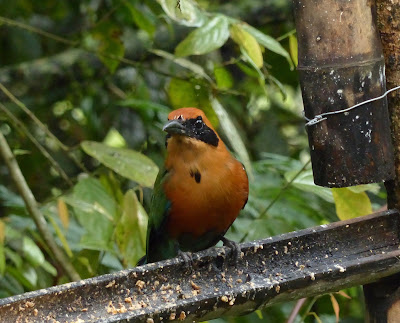Another Tandayapa Lodge gift were the Toucan Barbets (Semnornis ramphastinus).
We saw the Toucan Barbet again on our final day, but this was our TB photo-shoot.
I really like this bird's blend of colors.
Moth offering to mate.
The Lodge had a sheet tied between two trees outside of its sitting room's picture window. As far as I could tell, a black light shined on it 24 hours a day. Moths and beetles came to the sheet at all hours, but the big haul was obviously early morning when it was covered on both sides. Birds flew into the sheet to snatch a moth. Occasionally the moth would escape only to fall to the ground where the little birds would hunt them down. But, the big birds, like the Toucan Barbet or the Rufous Motmot flew into the sheet with a thud to snatch a moth. In the two photos above the bird on the left is feeding a moth to the bird on the right.
What a great looking bird!










































































